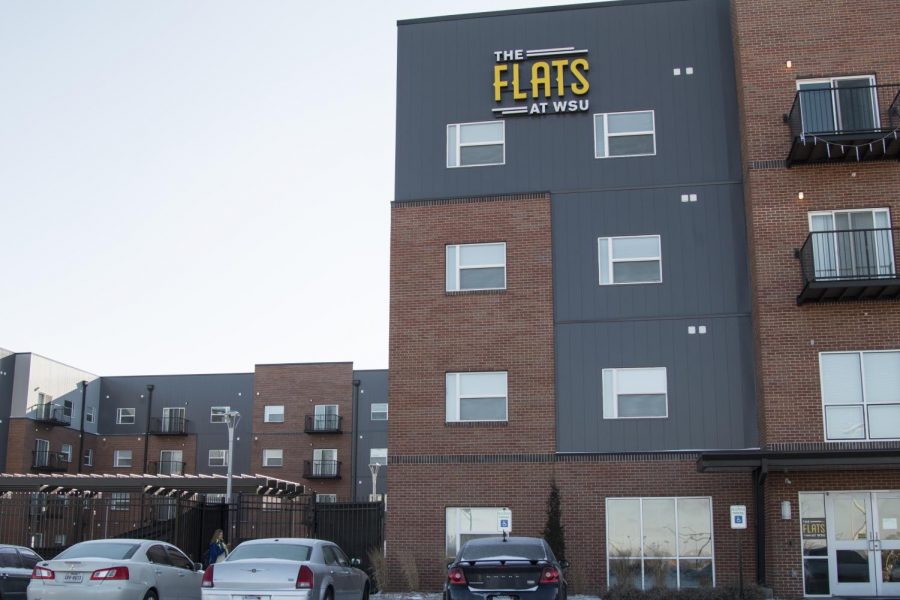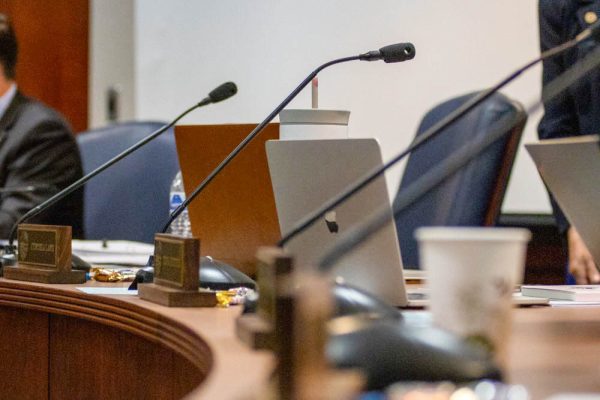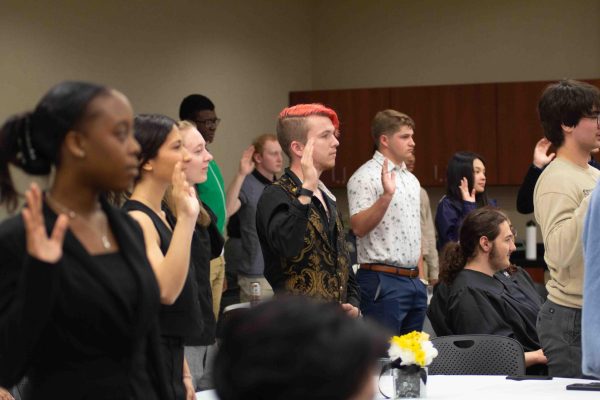Off-campus housing costs hundreds less per month than WSU options
The Flats is a private apartment complex located on Innovation Campus.
A Wichita State student with a roommate in a two-bedroom dorm at The Suites or Shocker Hall will pay the university $938 a month next school year, not including a required meal plan.
Students staying in a two-bedroom apartment at 2909 Oliver this year each pay $555 a month plus electricity overages. Two-bedroom monthly rates at the University Court apartments across 17th Street from campus start as low as $425 before electricity and a $20 water fee.
The cheapest on-campus living option at WSU is a six-person, two-bedroom offering in Shocker Hall. Living three people to a room will cost each student $578 a month next school year.
Mark Farha, owner of Farha Development, told The Sunflower last March that on-campus housing prices have created “one hell of an opportunity” for him.
“You’re pricing 80% of the kids out of the market by charging them what they’re charging them on campus,” Farha said.
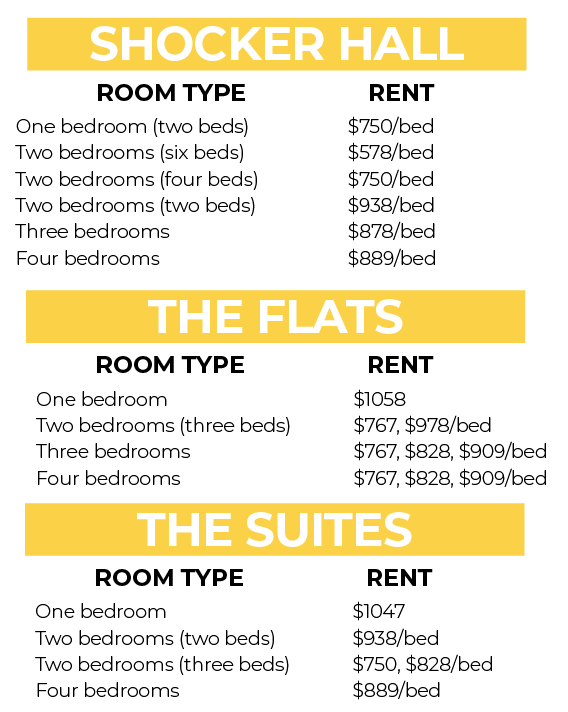
Katie Austin, marketing and outreach coordinator for Housing and Residence Life, said getting the best price point isn’t what motivates students to live on campus.
“Most people aren’t choosing to live on campus because it’s either the most space or they’re getting the best square footage deal,” Austin said. “It’s those extras — it’s that community piece and that convenience piece that really draw folks on campus.”
First-year students are required to live on campus, although they can opt out if they are 21 years old or older, enrolled part-time, transferring at least 24 credit hours, or living in a fraternity or sorority house or with an approved relative.
All students living on campus are also required to buy a meal plan. Plans range from $1,000 to $5,080 per year. The cheapest meal plan available to first-year students is $4,430, which averages out to $492 a month over the course of a nine-month stay.
Austin said student housing implements a roommate-matching software program and boasts resident assistants on every floor and a maintenance staff that is “highly responsive after hours.”
Asked if the convenience and sense of community on campus make living there worth the extra money, freshman Shocker Hall resident Nathan Dalby didn’t mince his words.
“No, I’m moving off campus next year.”
“It’s not bad,” he said of Shocker Hall. “It’s just a lot more money than we could be paying out there.”
Kylee Frank is a freshman Shocker Hall resident who works as a project assistant for Housing and Residence Life. She said living on campus makes sense for new students, but she’s not convinced it’s the best long-term option.
“For first-year students, I think it’s worth it because you get to be close to your classes and you get to be close with people that are going to be in your classes,” Frank said.
“But after that, you know, you’ve already made your connections that you’re going to make, most likely, and so at that point, you might as well save yourself some money.”
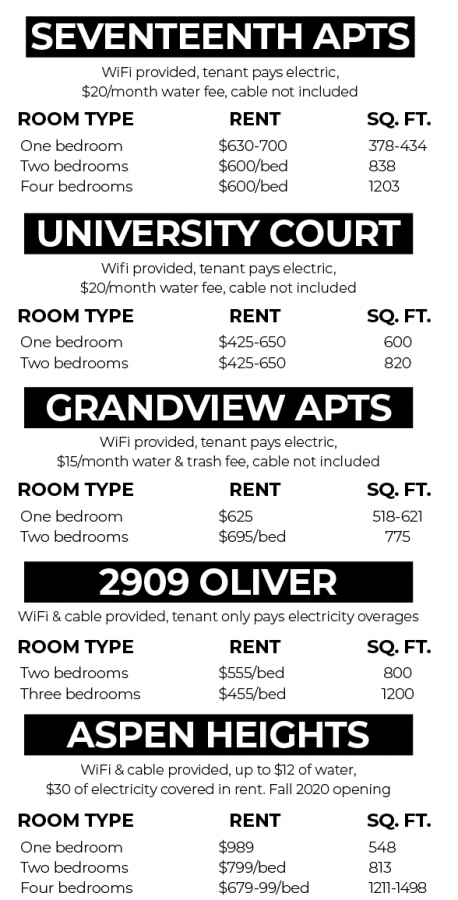
Across the board, off-campus housing options cost significantly less than their WSU counterparts.
Students who want to live alone in a one-bedroom dorm at WSU will have to pay either $1,047 a month at The Suites or $1,058 a month at the Flats. The only single-bedroom off-campus offering in the same range is a $989 monthly rate at Aspen Heights, a new apartment complex opening this fall.
Single-bedroom rates at the Seventeen60 apartments range from $600 to $650, and the Grandview Apartments’ offering splits the difference at $625 a month.
Students living on campus pay nothing extra for utilities and have complimentary WiFi and cable. Most off-campus apartments near the university have some monthly utilities costs but roll at least WiFi into rent.
The 2909 Oliver complex, roughly one-and-a-half miles from campus, provides tenants with both free WiFi and cable. Tenants pay nothing for water or trash, and the apartments foot most of the electricity bill — tenants only pay overages.
“I do feel like housing on campus is a little overpriced, but like, the convenience of it kind of makes up for it a little bit.” — Elise McCoy, sophomore Flats resident
One pitch property managers across 17th Street make to prospective student tenants is that housing just south of campus is actually closer to the Rhatigan Student Center, the hub of WSU’s main campus, than The Flats and The Suites, which are located on Innovation Campus.
Sophomore Flats resident Elise McCoy said her apartment is “really nice” and that “it’s still not that bad of a walk” to the main campus. That doesn’t mean it makes financial sense for everybody, she acknowledged.
“I do feel like housing on campus is a little overpriced, but like, the convenience of it kind of makes up for it a little bit,” McCoy said. “But other than that, if money’s an issue, then I’d go ahead and move off campus.”
Sophomore Flats resident Taylor Poling said she has not enjoyed living on campus and plans to move out next semester.
“Yeah, it’s safe and everything, but there’s just so many cons to it — like parking,” Poling said. “If there’s not any parking here, you have to park all the way at Eck (Stadium) and walk.”
According to a recently released Housing and Residence Life survey, 81.2% of Flats and Suites residents say living on campus has positively impacted their academic performance. Sixty-three percent of residents agreed or strongly agreed that living on campus gave them a better understanding of the resources available to students.
Demand for on-campus housing is high, Austin said. According to Housing and Residence Life’s weekly application figures, there are 983 completed student housing contracts so far — 35 more than at this time last year. There are also 374 returning students living on campus, which is 39 more than at this time last year.
“We’re not just in it for the bottom line.” — Katie Austin, Housing and Residence Life outreach and marketing coordinator
Austin said that even though university housing rates are comparatively high, they offer students plenty of flexibility.
“We’re not just in it for the bottom line,” Austin said. “If we see that we have more folks that are wanting a lower cost, we can maybe make more doubles (two students in a bedroom meant for one). We can look at different options. We can change based on demand, you know. Where other places are always trying to make that bottom line, we have an educational component to that.”
Online floor plans for Shocker Hall, The Suites, and The Flats make no mention of apartment size. Pressed to provide a square footage range, Austin said she was uncomfortable doing so because there is so much variability.
“We generally don’t speak in kind of the square footage terms because there is such a wide variety,” she said. “A corner room could be bigger than an average room. There’s just a lot of discrepancy, and so if you start putting that in brochures, people really hold you to that.”
Austin emphasized again that price and apartment size are not top selling points for on-campus housing. She said she’s glad students have plenty of living options around campus.
“We want to offer students quality housing around the area, and we only have so much returning student housing to offer at this point in time,” Austin said.
“We’re happy that there’s more options for students. We think that’s a good thing, and we think that we can still compete.”
The Kansas Board of Regents approved next year’s on-campus housing rates in December. Single-room rates will increase from this year while some double- and triple-room rates are going down slightly.
Some off-campus apartments will also change rates between now and the beginning of next school year.

Matthew Kelly is a former editor-in-chief and managing editor for The Sunflower. Kelly graduated in 2020 with a bachelor’s degree in political science...



